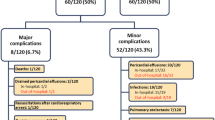Abstract
Surgical repair for atrial septal defects (ASD) generally occurs during childhood. Post-pericardiotomy syndrome (PPS) after cardiac surgery has a reported incidence of 1–40 %. We focused exclusively on secundum ASD repair to evaluate the incidence of PPS. The purpose of this study is to determine the incidence of PPS after surgical repair of secundum ASD and investigate what risk factors may be predictive of its development. A retrospective study was performed, and 97 patients who underwent surgical closure of a secundum ASD were identified. 27 (28 %) were diagnosed with PPS within the first postoperative year. Diagnosis was made if they had evidence of new or worsening pericardial effusion and the presence of ≥2 of the following criteria: fever >72 h postoperatively, irritability, pleuritic chest pain, or pericardial friction rub. Closure of secundum ASDs was performed at a median age of 3.8 years (Interquartile Range (IQR): 2.2–6.0 years) and a median weight of 14.3 kilograms (IQR: 10.9–19.3 kilograms). The median time for development of PPS was 8 days post-op (IQR: 5–14). Significantly, 19 (27 %) of 70 patients in the non-PPS group had a small pericardial effusion on their discharge echocardiogram, while of the 27 patients who developed PPS, 17 (63 %) had a small pericardial effusion on their discharge echocardiogram (p = 0.001). PPS is relatively common following surgical closure of secundum ASDs. A small pericardial effusion on discharge echocardiogram is predictive of development of PPS postoperatively. In patients who develop PPS, there is a good response to therapy with a benign course.
Similar content being viewed by others
References
Ferencz C, Rubin JD, McCarter RJ, Brenner JI, Neill CA, Perry LW, Hepner SI, Downing JW (1985) Congenital heart disease: prevalence at livebirth. The Baltimore-Washington Infant Study. Am J Epidemiol 121(1):31–36
Carlgren LE (1959) The incidence of congenital heart disease in children born in Gothenburg 1941-1950. Br heart J 21(1):40–50
Hoffman JI, Kaplan S (2002) The incidence of congenital heart disease. J Am Coll Cardiol 39(12):1890–1900
Moss AJ, Adams FH, Emmanouilides GC (1995) Moss and Adams heart disease in infants, children, and adolescents : including the fetus and young adult, 5th edn. Williams & Wilkins, Baltimore
Murphy JG, Gersh BJ, McGoon MD, Mair DD, Porter CJ, Ilstrup DM, McGoon DC, Puga FJ, Kirklin JW, Danielson GK (1990) Long-term outcome after surgical repair of isolated atrial septal defect. Follow-up at 27 to 32 years. The New England journal of medicine 323(24):1645–1650. doi:10.1056/NEJM199012133232401
Roos-Hesselink JW, Meijboom FJ, Spitaels SE, van Domburg R, van Rijen EH, Utens EM, Bogers AJ, Simoons ML (2003) Excellent survival and low incidence of arrhythmias, stroke and heart failure long-term after surgical ASD closure at young age. A prospective follow-up study of 21–33 years. Eur heart J 24(2):190–197
Zea Du (2002) Comparison between transcatheter and surgical closure of secundum atrial septal defect in children and adults. J Am Coll Cardiol 39(11):1836–1844
Bichell DP, Geva T, Bacha EA, Mayer JE, Jonas RA, del Nido PJ (2000) Minimal access approach for the repair of atrial septal defect: the initial 135 patients. Ann Thorac Surg 70(1):115–118
Baskett RJF, Tancock E, Ross DB (2003) The gold standard for atrial septal defect closure. Pediatr cardiol 24(5):444–447. doi:10.1007/s00246-002-0131-6
Gill PJ, Forbes K, Coe JY (2009) The effect of short-term prophylactic acetylsalicylic acid on the incidence of post-pericardiotomy syndrome after surgical closure of atrial septal defects. Pediatr cardiol 30(8):1061–1067. doi:10.1007/s00246-009-9495-1
Imazio M, Brucato A, Rovere ME, Gandino A, Cemin R, Ferrua S, Maestroni S, Barosi A, Simon C, Ferrazzi P, Belli R, Trinchero R, Spodick D, Adler Y (2011) Contemporary features, risk factors, and prognosis of the post-pericardiotomy syndrome. Am J cardiol 108(8):1183–1187. doi:10.1016/j.amjcard.2011.06.025
Imazio M, Brucato A, Adler Y (2012) Is possible to prevent the Post-Pericardiotomy Syndrome? Int J Cardiol 159(1):1–4. doi:10.1016/j.ijcard.2012.01.034
Timmis GC, Gordon S, Ramos RG (1971) Recurrent post-pericardiotomy syndrome. Its protracted nature and association with atrial septal defects. Mich Med 70(13):539–542
Imazio M, Trinchero R, Brucato A, Rovere ME, Gandino A, Cemin R, Ferrua S, Maestroni S, Zingarelli E, Barosi A, Simon C, Sansone F, Patrini D, Vitali E, Ferrazzi P, Spodick DH, Adler Y, Investigators C (2010) COlchicine for the Prevention of the Post-pericardiotomy Syndrome (COPPS): a multicentre, randomized, double-blind, placebo-controlled trial. Eur Heart J 31(22):2749–2754. doi:10.1093/eurheartj/ehq319
Imazio M, Brucato A, Ferrazzi P, Spodick DH, Adler Y (2013) Post-pericardiotomy syndrome: a proposal for diagnostic criteria. J Cardiovasc Med 14(5):351–353. doi:10.2459/JCM.0b013e328353807d
Kutty S, Hazeem AA, Brown K, Danford CJ, Worley SE, Delaney JW, Danford DA, Latson LA (2012) Long-term (5- to 20-year) outcomes after transcatheter or surgical treatment of hemodynamically significant isolated secundum atrial septal defect. Am J Cardiol 109(9):1348–1352. doi:10.1016/j.amjcard.2011.12.031
Imazio M (2012) The post-pericardiotomy syndrome. Curr Opin Pulm Med 18(4):366–374. doi:10.1097/MCP.0b013e32835311a2
Janton OH, Glover RP, Oneill TJE, Gregory JE, Froio GF (1952) Results of the Surgical Treatment for Mitral Stenosis - Analysis of 100 Consecutive Cases. Circulation 6(3):321–333
Ito T, Engle MA, Goldberg HP (1958) Post-pericardiotomy syndrome following surgery for nonrheumatic heart disease. Circulation 17(4, Part 1):549–556
Imazio M, Brucato A, Markel G, Cemin R, Trinchero R, Spodick DH, Adler Y (2011) Meta-analysis of randomized trials focusing on prevention of the post-pericardiotomy syndrome. Am J Cardiol 108(4):575–579. doi:10.1016/j.amjcard.2011.03.087
Mott AR, Fraser CD Jr, Kusnoor AV, Giesecke NM, Reul GJ Jr, Drescher KL, Watrin CH, Smith EO, Feltes TF (2001) The effect of short-term prophylactic methylprednisolone on the incidence and severity of post-pericardiotomy syndrome in children undergoing cardiac surgery with cardiopulmonary bypass. J Am Coll Cardiol 37(6):1700–1706
Belay ED, Bresee JS, Holman RC, Khan AS, Shahriari A, Schonberger LB (1999) Reye’s syndrome in the United States from 1981 through 1997. N Engl J Med 340(18):1377–1382. doi:10.1056/NEJM199905063401801
Author information
Authors and Affiliations
Corresponding author
Rights and permissions
About this article
Cite this article
Heching, H.J., Bacha, E.A. & Liberman, L. Post-Pericardiotomy Syndrome in Pediatric Patients Following Surgical Closure of Secundum Atrial Septal Defects: Incidence and Risk Factors. Pediatr Cardiol 36, 498–502 (2015). https://doi.org/10.1007/s00246-014-1039-7
Received:
Accepted:
Published:
Issue Date:
DOI: https://doi.org/10.1007/s00246-014-1039-7



